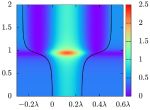EPJ D Highlight - Atoms crystallised by light for precision measurement
- Details
- Published on 26 November 2014

A new study focuses on the collective dynamics of illuminated atoms coupled to photons travelling in a nanofiber
Theoretical physicists have uncovered the existence of self-organised dynamics of atoms, bound by light into a crystal, with long range atom-atom interactions. These findings were recently published in EPJ D by Daniela Holzmann from the University of Innsbruck, Austria, and colleagues. This approach could, among others, help to better understand the process of crystallisation in new materials, and help implement efficient photon storage and precision measurements. Applied to ultra-cold atoms, it could aid in the study of long-distance interactions in the quantum dynamics of one-dimensional non- conventional materials, referred to as exotic matter.
Their study focuses on atoms trapped in the leaked light very close to a tapered optical nano-fibre. Such fibres are too thin to confine all the light within, similar to an overflowing river. These atoms are exposed to a transverse laser beam, whose light becomes partially redirected, or scattered, into the nanofiber at each atom’s position, before propagating along the chain of atoms. It thus mediates mediates a strong effective atom-atom interaction.
Holzmann and colleagues adapted a well-established one-dimensional model of atom-light interactions to account for the scattering process. There, every atom is described by the amount of light it reflects and transmits, like a bad mirror. The novelty of the study is to include the scattered light entering the setup at the atom’s position, like a bad mirror with a light source.
The authors came to the surprising conclusion that this approach yields a stable chain of atoms, bound by light, forming a crystal. There, the atoms collectively create their own traps—and are not in predefined positions. Meanwhile, atoms at the edge confine as much light as possible within the structure, resulting in a self-forming adaptive optical resonator, which is potentially useful for precision measurement, quantum simulation and quantum information storage.
D. Holzmann, M. Sonnleitner and H. Ritsch (2014), Self-ordering and collective dynamics of transversely illuminated point-scatterers in a 1D trap, European Physical Journal D, DOI: 10.1140/epjd/e2014-50692-2




